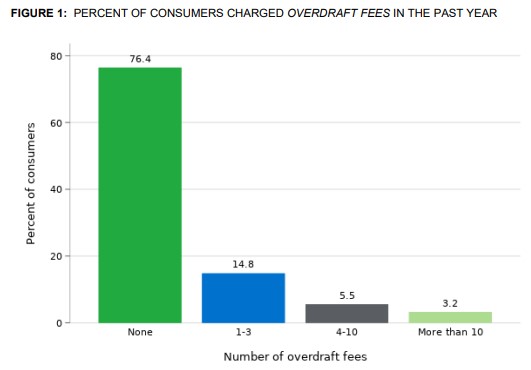 Despite changes in legislation and changes by banks themselves to make overdraft and nonsufficient fund fees (also called junk fees in some circles) more transparent, billions of dollars in fees are still charged to consumers every year according to the Consumer Financial Protection Bureau (CFPB).
Despite changes in legislation and changes by banks themselves to make overdraft and nonsufficient fund fees (also called junk fees in some circles) more transparent, billions of dollars in fees are still charged to consumers every year according to the Consumer Financial Protection Bureau (CFPB).
A new report authored by the CFPB entitled “Making Ends Meet,” found that more than a quarter of consumers responded that they—or someone in their household—was charged an overdraft or NSF fee within the past year, and that only 22% of those people expected their most recent fee. Other consumers appear to use overdrafts often and intentionally: in households charged more than 10 such fees in a year, more than half of respondents reported that they expected their most recent overdraft. Most account overdrafts are exempt from the regulation implementing the Truth in Lending Act, which is designed to promote the informed use of credit and make it easier for consumers to compare the cost of credit products.
Further, many consumers who were charged overdraft fees had access to a cheaper alternative, such as available credit on a credit card.
“Our research finds that American families are paying fees they do not expect, even when they have access to cheaper forms of credit,” said CFPB Director Rohit Chopra.

Key findings from surveyed households and consumers in the report, as highlighted by the CFPB, include:
- Households frequently incurring overdraft and NSF fees are more likely to struggle to meet their financial obligations: Among households that frequently incurred overdraft/NSF fees, 81% reported difficulty paying a bill at least once in the past year. This drops to 25% for households that were not charged a fee.
- Many consumers do not expect overdraft fees: Among consumers in households charged an overdraft fee in the past year, 43% were surprised by their most recent account overdraft, 35% thought it was possible, and only 22% expected it. Consumers who overdraft infrequently are more likely to be surprised by a fee: 15% of consumers from households charged 1 to 3 overdraft fees expected their most recent transaction to overdraft; among households charged more than 10 overdraft fees, 56% expected their most recent overdraft.
- Most households incurring overdraft fees had available credit on a credit card: Among households charged 1-3 overdraft fees in the past year, 68% had credit available on a credit card, while 62% of households charged 3-10 overdraft fees had credit available on a credit card. In households charged more than 10 fees in the past year, 51% still had credit available on a credit card.
- Households face a substantial overlap in being charged overdraft and NSF fees: Among consumers in households charged an NSF fee in the past year, 85% were also charged an overdraft fee. Among consumers in households charged an overdraft fee in the past year, 72% were also charged an NSF fee.
- Low-income households are hit the hardest Overdraft and NSF fees: While just 10% of households with over $175,000 in income were charged an overdraft or an NSF fee in the previous year, the share is three times higher (34%) among households making less than $65,000.

The data for the report comes from the 2023 Making Ends Meet survey and the CFPB’s Consumer Credit Panel. The survey asks consumers about their experiences with overdraft and NSF fees in the past year, as well as their experiences applying for and obtaining credit, use of alternative financial services (e.g., payday or auto title loans), and financial pressures (e.g., difficulty paying bills or carrying an unpaid balance on a credit card).
Click here to read the report in its entirety.

 DSNews The homepage of the servicing industry
DSNews The homepage of the servicing industry









